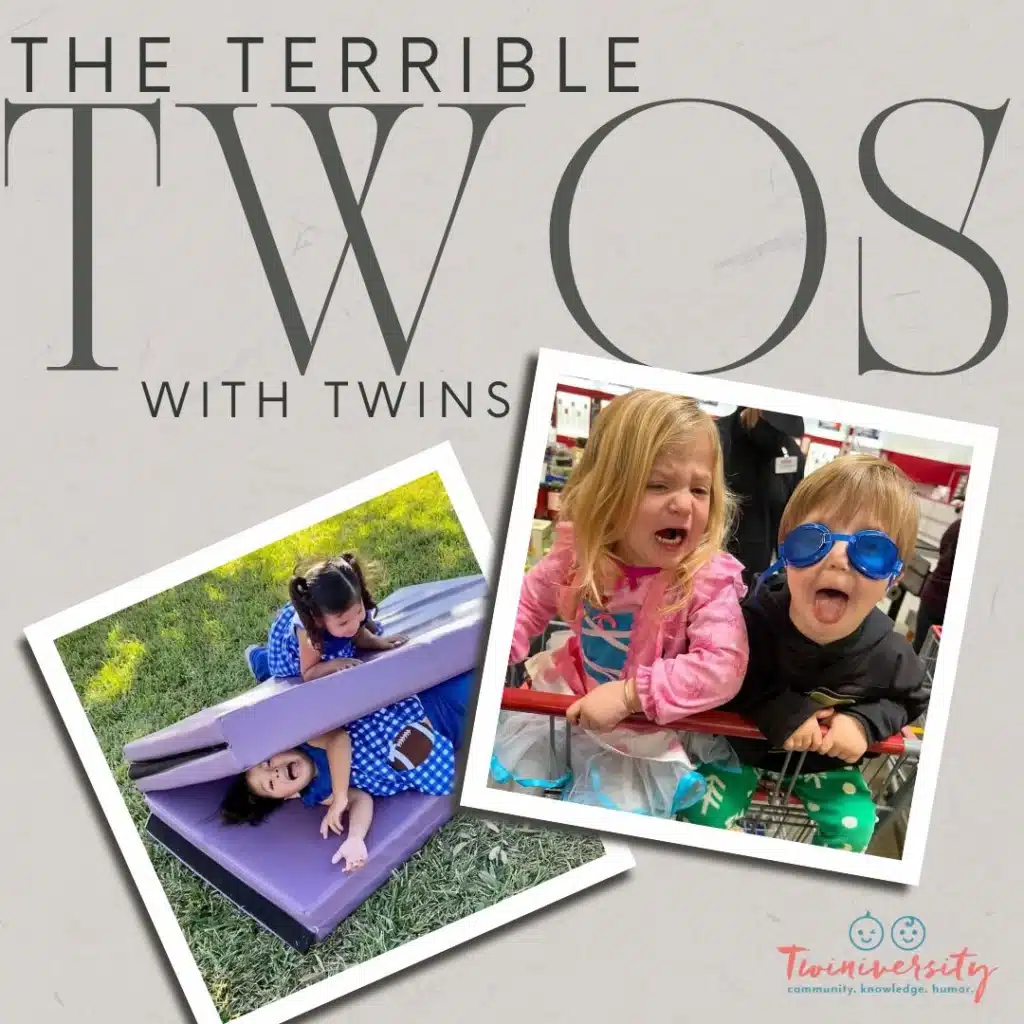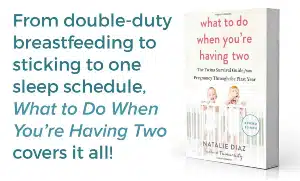Last updated on May 21st, 2024 at 09:55 am
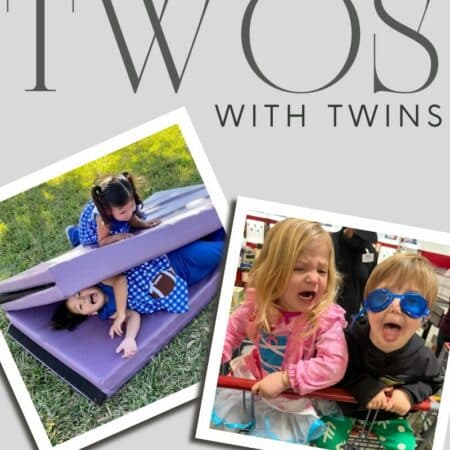
The terrible twos. We’ve all heard the phrase and have probably witnessed it in public at least once, even if we didn’t realize it. I heard a standup comic say, “Nobody talks about the toddler stage cause they’re terrors!” Ha! That gave me a good chuckle, but the truth is, the underlining of her jokes were all real and true. I guess that’s one bright side to the terrible twos with twins; it’s funny when it’s not happening to you.

Picture this: you ask your twins to wear a red shirt instead of a blue shirt, and instead of a “yes, mommy, whatever you say, mommy,” your child(ren) flings themselves to the ground and starts flopping around as if they were a fish out of water. Sound familiar? Well, my friend, in case you didn’t know, you are currently navigating the terrible twos with twins! So, what do you do when there are two that are terrible? Keep reading because we’ve got the strategies to save your sanity!
What is the Terrible Twos?
According to the American Academy of Pediatrics (AAP), “the terrible twos are characterized by increased physical activity, more expressive emotions, mood swings, and temper tantrums.” Now, we must mention that although this phase of childhood is called the terrible twos, these behaviors can start before age two and extend beyond it, varying widely from child to child. Either way, the terrible twos is the age where kids develop their own desires but have not yet mastered the art of expressing those desires.
Need some twin parent friends? Get the support you need with a Twiniversity Membership. Benefits include a monthly twin parent club meeting on Zoom, access to a private Facebook group just for twin parents, and a video library of twin parenting lessons. Visit Twiniversity.com/membership to join today!
How do you know you’re in the thick of Terrible Twos?
Here are some telltale signs that you’ve entered the chaos zone:
- Tantrum Central: Suddenly, everything becomes a potential reason for a meltdown. From the color of their cup to the fact that you won’t let them eat the dog’s food, tantrums can erupt with impressive frequency and intensity.
- “No” is Their Favorite Word: If “no” has become your toddler’s go-to response for anything and everything, welcome to the club. They might even say “no” to things they actually want just because they can.
- Testing Boundaries: Toddlers at this age are experts at pushing limits. They might repeatedly do something you’ve asked them not to, just to see how you’ll react. It’s like they’re running experiments to find out where the boundary lines are.
- Mood Swings: One minute, they’re giggling like crazy; the next, they’re inconsolable. The emotional rollercoaster is real, so buckle up and don’t forget to breathe!
- Selective Listening: Suddenly, your voice becomes a distant background noise when they’re focused on something else—usually something they shouldn’t be doing. It’s like they’ve developed an invisibility cloak for their ears.
- Clinginess and Independence: They might go from clinging to your leg to pushing you away because they want to do something by themselves. It’s a constant dance between “I need you” and “I can do it myself!”
- Resistance to Routines: Bedtime, mealtime, bathtime—basically, any “time” can become a battleground. If it involves a routine or following instructions, expect a challenge.
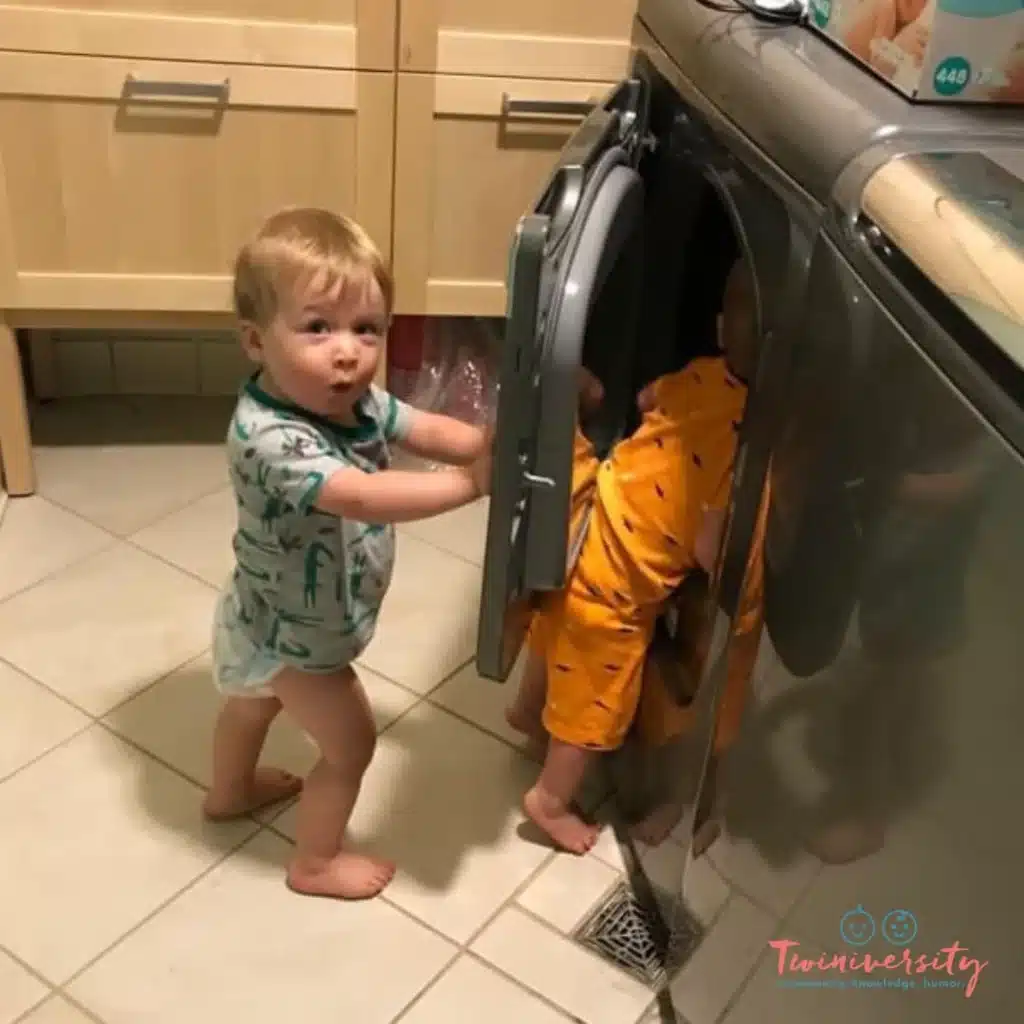
Now that we’ve unpacked what the terrible twos look like, let’s talk about some strategies to manage those inevitable meltdowns.
Here are some strategies to help you navigate the terrible twos with twins:
Don’t Mess With Eating Schedules
Regular meals and snacks help maintain stable blood sugar levels, which can influence a toddler’s mood and behavior. When kids get too hungry, they can become irritable and more likely to act out. Plan meals and snacks at consistent times each day, ensuring they have a balanced diet with a good mix of proteins, carbs, and healthy fats. Keep snacks on hand for when hunger strikes unexpectedly, and try to avoid long stretches without food.
Give Them a Heads-up About Potential Triggers
Toddlers often struggle with transitions and new experiences. Talking them through what will happen ahead of time can ease anxiety and prevent meltdowns. For example, if you know you’re going to the doctor’s office, explain in simple terms what to expect. Use storytelling, toys, or role-playing to help them visualize the experience. By setting expectations, you can reduce fear and give them a sense of control over the situation.

Don’t Cave In
Sticking to your boundaries can be challenging, especially when faced with a full-blown tantrum. However, consistency is crucial for teaching toddlers about limits and consequences. If you cave into their demands during a tantrum, they learn that this behavior gets them what they want. Instead, remain calm, stay firm in your decisions, and offer comfort without giving in to unreasonable demands. Over time, they’ll understand that tantrums aren’t an effective strategy for getting their w
Avoid Boredom
Boredom can lead to mischief and tantrums, so it’s important to keep toddlers engaged and entertained. Create a variety of activities that stimulate their senses and encourage exploration. This could include art projects, building blocks, outdoor play, or interactive storytelling. Rotate toys and activities to keep things fresh, and be sure to join in the fun when you can. When they’re busy and happy, there’s less room for trouble.
Be Consistent
Consistency helps toddlers feel secure and understand what is expected of them. Whether it’s bedtime, mealtime, or discipline, keeping a consistent approach reduces confusion and makes it easier for them to follow rules. Establish clear routines and stick to them as much as possible, even when you’re tired or busy. When toddlers know what to expect, they’re less likely to act out due to uncertainty.
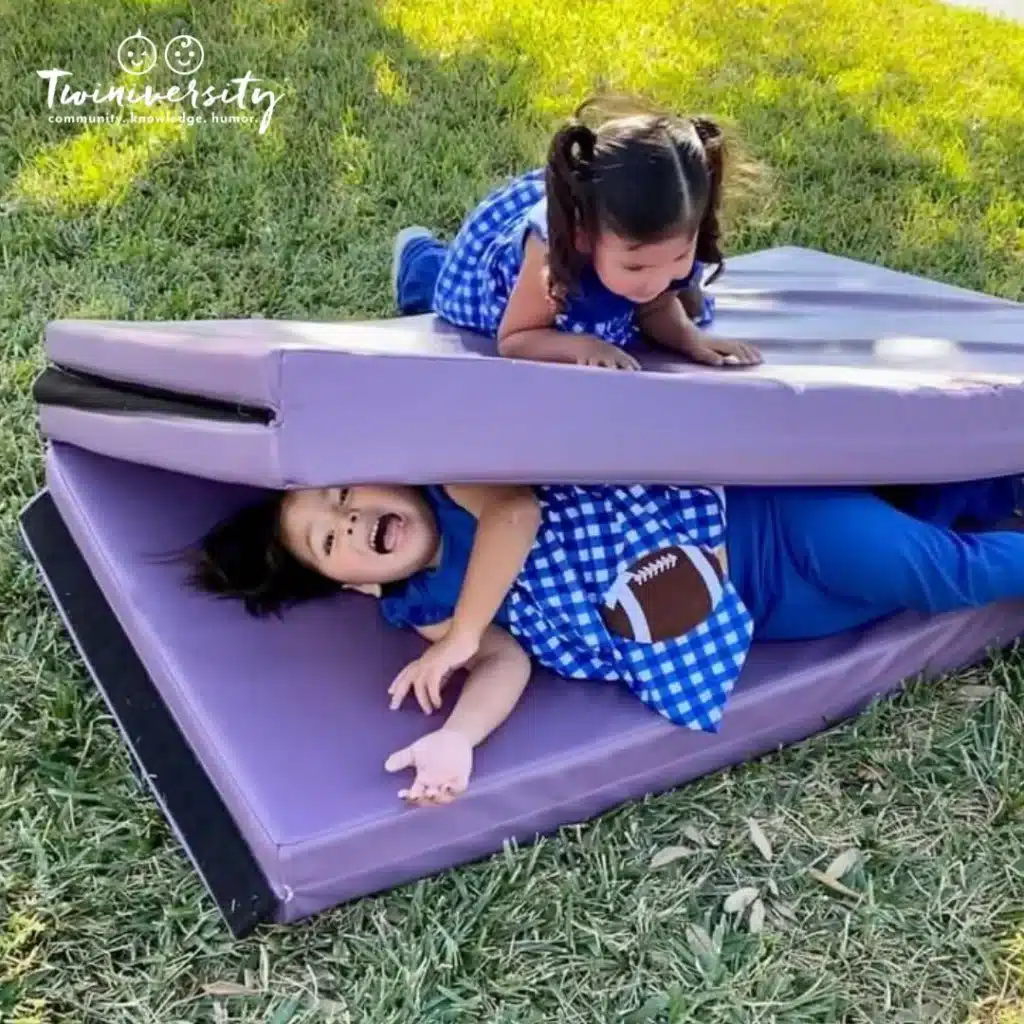
Change Direction When Needed
Toddlers can get fixated on things they shouldn’t do, leading to frustration for everyone involved. Instead of constantly saying “no,” try redirecting their attention to a more appropriate activity. For example, if they’re drawing on the walls, offer them paper or a chalkboard instead. Redirection is a positive way to guide behavior without escalating the situation. By shifting their focus, you can prevent a potential meltdown and encourage more appropriate play.
Are you thinking this all ends once the twins turn three? Check out Can We Talk About Three Old Twins.
Check out all our Twiniversity merch in our SHOP! We’ve got twin mom and dad t-shirts, twin planning printables, lactation support, twin baby shower planners & games, a digital twin pregnancy journal, and so much more! Start shopping now
When All Else Fails, Take a Break!
As you’re reading this, you’re now thinking how do you establish these boundaries with two? Especially when one twin starts crying, the other will chime in and cry louder. This behavior has been given a name by the twin parent community: twin escalation syndrome. Isn’t it lovely? Not that this happens to all twins. On occasion, one of my twins will grow quiet while the other one has a meltdown. However, one piece of advice stood out for me: Take A Break! This advice was given to me by my mother-in-law, who has identical twin daughters. Breaks are important so you can be the best version of yourself for your twins. Otherwise, your mental, emotional, and physical battery is drained. Without breaks, you will be irritable, short-tempered, and tired, all of which are not good for your health!
Whether you’re in the thick of the terrible twos or just preparing for them, it can be challenging. But remember, these are just a few trying moments—fleeting episodes within the span of brief moments in the 24-hour day. The rest of the time, twos are such an amazing age! They’re exploring, learning, and amazed at the world around them. Have patience, and give yourself grace during this time. And take breaks, lots of breaks!

Stephanie Miller is the proud mom of twin cyclones Zach and Carter (20-month-old). Every day in the Miller house, you’ll find rooms turned over, floors covered in bits of Lego and puzzle pieces (mind your step), and the sound of “Brown Bear Brown Bear” read over and over, and over again. You’ll typically find her being used as the seat to reading time for the two bookworms, covered in bubble solution as they try to excel in their Bubble Wand skills, or being the voice to command Alexa for their favorite tunes. She and her husband are working on their traveling skills cause she can’t wait to show them the amazing world that is out there for them.

